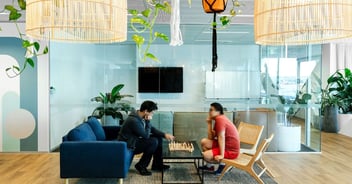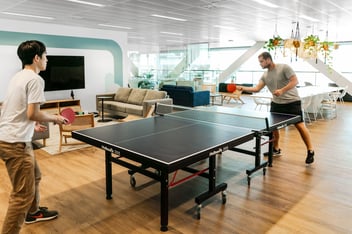The workplace is changing around us as we speak. With more and more people working remotely or with flexible work arrangements, employers are facing new challenges daily in how they create a positive company culture, enable collaboration, attract new talent and plan for growth.
Because of this, there is a serious conversation happening all over the globe about what the future of work and its workforce will look like. We’re in the middle of a massive overhaul of the workplace as we once knew it. The questions we are constantly being asked, and asking of ourselves, is how we can better shape workplaces to accommodate these shifts, while also future-proofing and facilitating these new ways of working.
With this is mind, we invited Cindy Lenferna De La Motte, Future of Work Strategist and Head of Customer and Community at Harvest Digital Planning, to join Annelie Xenofontos, Axiom’s Senior Workplace Strategist, to lead a conversation on company culture, how to create intelligent workplace design outcomes and the future of the workplace. The answers below are a summary of both their responses during the event.
What are the key challenges of the future workplace?
It’s here, it’s arrived and we are already working in this ‘future’ workplace. The key challenge here is the pace of the evolution, and how businesses and employees are keeping up.
Professional development, once considered a 'nice-to-have,' has now become a critical 'must-have' in the evolving future of work. Future of work strategists emphasize that individuals should dedicate three hours per week to enhancing their skills, ensuring they stay relevant and adaptable in the workplace over the next 25 years. By prioritizing continuous learning, professionals can future-proof their careers and remain competitive in an ever-changing job market.
Upskilling and innovation play a massive role; businesses alone cannot afford or accommodate the pace of upskilling that individuals need to keep up with the digital evolution that’s happening. Employees need to take on this growth mindset and responsibility for themselves, and employers need to wholeheartedly support and facilitate their learning.
Those in senior roles, leading business change and growth, cannot rest on their tried and tested measures. Instead, they must lead the way in updating their knowledge and learning so as to drive innovation both in their businesses and in their staff, ensuring their business remains competitive and up-to-date.
There are numerous meet-ups, short courses, podcasts, reading material and forums to meet up with other people, learn and share information. Gone are the days of doing a university degree that will see you through a job for life and into retirement. The lifetime of learning in degrees is now estimated to be three to five years post-graduation, so adopting a new approach and mindset to lifelong learning, even into retirement, is part of the future of work evolution.
From a workplace perspective, customisation is now a baseline requirement. We don’t want to fit in a box anymore. We are working in more sophisticated ways, and we want and expect a customised work environment that supports innovation, creativity and efficiency.
Businesses need to constantly think about what is next and their workplaces need to be conducive to thriving in this evolution.
What are the top skills needed for the future workplace?
Diversity and inclusion are topics that have been talked about for a while and are certainly on the HR agenda, but they need to be highly prioritised in the workplaces of the future. Workspaces need to be designed to facilitate the collaboration of employees of different ages, cultures and backgrounds, and to enable spontaneous conversations, innovation and learning to occur. The evolution of business practices doesn’t only come from business leaders anymore. It comes from every person in the workforce.
Young people coming into the workforce have a wealth of information to bring, while the current working generations have significant experience to draw on. Encouraging collaboration between generations through smart workplace design and technology allows a business and its staff to bolster and flex its knowledge base for now and into the future. This is where the magic of a diverse workforce happens.
In Australia, we are relatively good when it comes to creating a diverse workforce, particularly in larger cities, however inclusion of a diverse workforce still requires attention. We need to be choosing skills and capabilities over age, location and culture to keep our businesses at the forefront, and upskilling current team members into new roles to keep them relevant.
Is the war for talent real?
We have a skills shortage in Australia and the war for talent is real and fierce. According to the Australian HR Institute, there are almost one million more job opportunities than there are employed people in Australia.
The top companies are offering impressive compensation and benefit packages, which the most talented individuals are honing in on. And businesses are getting clever with what they are offering—thinking not just about more dollars, but also about the ways their staff want to work and live.
Your culture, mission, purpose and workspace have such an impact on your employer value proposition (EVP). From the moment someone walks into your office space, they think about whether it feels like a good company to work for. Is your office representative of your culture and attractive to talent?
A workplace that embodies the culture, mission and purpose of the company lives out its values and starts to hand back autonomy to staff, one of the biggest motivators for top talent. Invest in your employees through creating a space that’s meaningful to them and allows them to do their best work. Creating a comfortable work environment and reducing employee frustration are key metrics in your workspace design, as are:
- Green spaces
- Personalised spaces
- Quiet spaces
- Environmentally friendly processes
- A focus on health and wellbeing
- The opportunity for connection, creativity and deep work
Cindy says, “At Harvest Digital & Planning, we made a conscious decision to source the best candidates for skill and capability regardless of location. The world is literally our oyster and right now our team is 100 percent remote.”
Remote working comes with new challenges, but ones that we are working through, finding new ways to be inclusive and find the emotion in our day-to-day interactions as face-to-face teams do. With remote and flexible working becoming the norm, businesses and workplaces need to find new ways that work for them and their own cultures to address inclusion for remote teams. We don’t have all the answers but we are experimenting together.
What kind of technology and processes can you use to bring remote workers and workspaces together?
This will differ from organisation to organisation depending on your workplace culture and the type of work that you do. But at the heart of it is asking yourself what your team needs in order to stay connected at a human level, as well as at an operational level.
Some businesses initiatives that have worked for businesses we know are:
- Ensuring that all new employee onboarding is done face-to-face, even if that means flying someone to head office for an induction. Ensure that all managers of new staff make the time to make that face-to-face connection as this is the start of inclusion and sets the tone from the outset of the employment relationship.
- Connecting people back in through regular town halls or team-based meetings.
- Communication is critical so have a real-time tool like Slack or Skype for chat. This also helps reinforce culture.
- The “cupcake experience”: always consider who isn’t in the office to receive the cupcakes brought in by a team member. What can you do for those not getting a cupcake? It might seem like a small thing, but it goes miles when it comes to making a remote worker feel included.
- Pizza hour: bringing everyone together to eat pizza.
- Using emojis or gifs in communication allows emotion and sentiment to come through in email and internal comms.
Workplaces can evolve and flourish in businesses with lots of remote workers with some innovative thinking.
At Axiom, we encourage businesses we work with to think about how they might be innovative with their space depending on the outcomes they require. How much space do they really need? How can they reduce their environmental footprint, waste and cost by thinking about the way their staff will use the workspace?
Solutions such as agile working environments that chop and change according to business fluidity, spaces for technology that connect staff members both in-house and remotely, flexible working so spaces might be used differently on different days depending on who is in the office and the outcome they want to achieve, and even lending out space that is not used all the time—not only can it spark creative partnerships and collaborations but it’s also commercially viable.
Where do I start to futureproof my workplace?
Teaching new ways of work requires teaching individuals a growth mindset. For organisations and business owners, start with a small experiment or collaborate with a new partner to challenge your current ways of working.
Ask yourself, am I still doing the right thing? How could I reimagine my workforce connecting, thinking and innovating? Try something different that aligns with your business. Listen and engage your people and implement.
What are the top 3 things that a modern office should have for a thriving environment?
It’s a feeling thing! Each business has a different identity so it’s not a one size fits all approach. You have to tap in and consider what space and technology you need to create the feeling that you want your employees to have when they step into the office. You want staff to love going to work because it feels good.
Although we’re living through a period of rapid change and unprecedented uncertainty, there are still things businesses can do to future-proof their workplaces. Find out more about the future workforce in the Future of Work: A Progressive Leaders Guide To Staying Ahead






